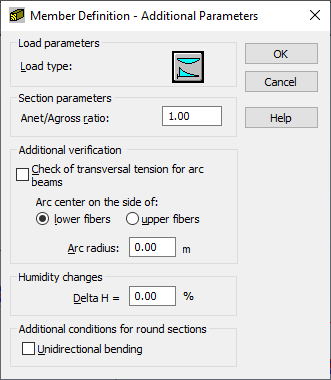This option defines additional code parameters for the timber bar type. It is available by clicking More in the Member Definition - Parameters dialog.

You can define the following additional bar parameters in the dialog:
- Load type
- Section parameters - Anet/Agross ratio which applies to a tensile force acting on the cable. It is a coefficient that defines the relationship of the member cross-section area, not considering the bolt or rivet openings (Anet), to the total cross-section area (Agross).
- Check of transversal tension for arc beams
For arc beams, a beam curve causes the generation of forces perpendicular to the plane of the adjacent layers. After the option Check of transversal tension for arc beams is selected, additional verification is conducted of the forces from a beam curve during the curved beam calculations. To perform this verification, you must specify the radius of the beam curve and determine if the arc center is on the side of lower or upper fibers.
- Humidity change
This parameter is used during θ coefficient calculation (a part of a long-term live load is multiplied by this coefficient). These calculations are performed when verifying a bar that accounts for code combinations for the serviceability limit state (deflection). The Humidity parameter defined in the Job Preferences is used to calculate the reduction coefficients, which are dependent on the humidity and stress type (Humcomp.coef and Humflex.coeff). This parameter is displayed in a detailed result table for timber bars.
- Additional conditions for round sections: unidirectional bending - if this option is selected, during the calculations of a member with a round section subjected to bi-axial bending, the moments My and Mz are replaced with a resultant moment as their vector sum. Because of that moment, Robot treats the member as a member subjected to unidirectional bending.
